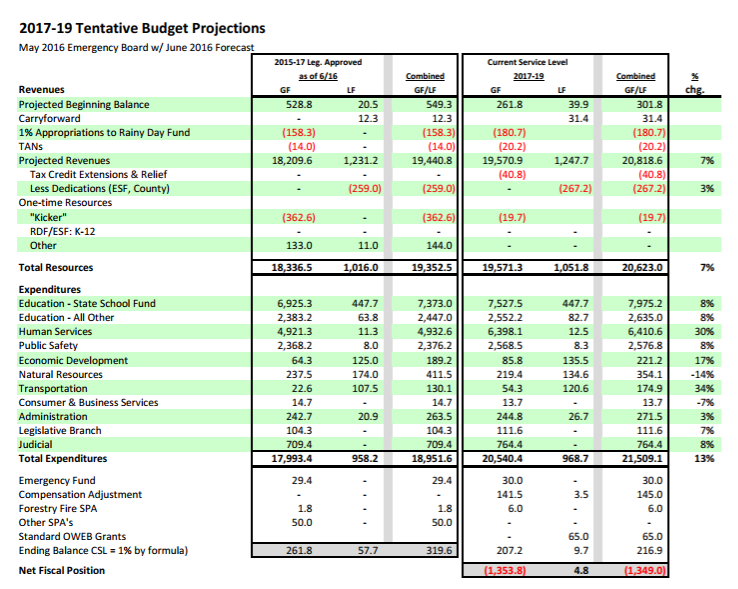As required by ORS 291.210, the Legislative Fiscal Office (LFO) and the Budget and Management Division (BAM) of the Department of Administrative Services’ (DAS) Chief Financial Office (CFO) have worked together to develop a projected tentative General Fund/Lottery Funds budget for the 2017-19 biennium.
The purpose of the tentative budget is to give policymakers an idea of the state’s relative fiscal position for the coming two-year budget period if the state was to continue all currently approved programs at their current law approved funding levels, adjusted for inflation, compensation roll-up costs, program phase-ins and phase-outs, and projected mandated caseload increases. This is commonly referred to as the Current Service Level (CSL). The current tentative budget is based on the June 2016 economic and revenue forecast and incorporates actions taken by the Legislature during the 2016 session and the May 2016 meeting of the Emergency Board. As directed by ORS 291.210, the tentative budget consists of “the estimated revenues under ORS 291.342 for the next biennium and a preliminary estimate of the projected costs of continuing currently authorized programs for the next biennium.”
It should be noted that the tentative budget for the 2017-19 biennium will change with each of the remaining four quarterly economic and revenue forecasts that will occur before the start of the next biennial budget period. It should also be emphasized that the tentative budget, as a current service level projection, only represents an estimate of the costs of continuing currently approved programs for the next two year budget period; it does not represent a guarantee of funding for any agency or program or include costs for any program currently not included in the state’s budget.
The current tentative budget for the 2017-19 biennium assumes the following statewide factors:
- Revenue growth is based on the Office of Economic Analysis (OEA) June 2016 economic and revenue forecast.
- State personal services growth is projected at 9% for the biennium, including step increases, roll-up of current collective bargaining agreements and management salary packages, health benefit costs, Pension Obligation bond payments, and an increase in the PERS rate.
- Standard biennial inflation of 3.7% for services and supplies and 4.1% for medical costs.
- Backfill of 2015-17 one-time funds with General Fund, or fund shifts, that change funding sources for programs between the two biennia, total a net $626 million. This is primarily in the Human Services and Education program areas, and includes $328 million related to an increasing state responsibility for Affordable Care Act costs and other federal match changes. LFO/CFO August 10, 2016
- The State School Fund (SSF) current service level budget is estimated to grow by 8.1% over the 2015-17 legislatively approved level, increasing to $7.975 billion General Fund and Lottery Funds. This growth is based on:
- the most recent actuarial PERS rate estimates for school districts (13.07% of payroll including school district side accounts, but excluding the pick-up);
- the Legislative Revenue Office current estimate of 2017-19 local revenues;
- annual payroll growth for school district employees of 2.1%;
- increases in health benefits as estimated by the Oregon Educators Benefits Board; and
- annal growth in the weighted average daily membership (ADM) of 0.42%.
- The 2017-19 current service level budget for state support of Public Universities, including $42 million in net debt service payments, is estimated to grow by a combined $77.6 million General Fund and Lottery Funds. The Community College Support Fund is estimated to grow by $13.9 million General Fund and net debt service payments on behalf of community colleges increases by another $9.9 million.
- Human services mandated caseload increases for the 2017-19 biennium are based on the Spring 2016 forecasts for the Oregon Health Authority and the Department of Human Services.
- Oregon Health Plan costs are inflated 3.4% per year, consistent with the state’s federal waiver agreement over the last several years.
- Existing debt service schedules are built into agency budgets based on current repayment schedules, which increases the tentative budget by $175.6 million.
- A General Purpose Emergency Fund of $30 million is included; no Special Purpose Appropriations to the Emergency Board are assumed except for $6 million for forest fire suppression and insurance costs.
- A compensation adjustment of $145 million is included primarily to address future collective bargaining agreements.
- The Natural Resources program area shows a decline of 14% between the CSL and the 2015-17 legislatively approved budget due to a technicality. Oregon Watershed Enhancement Board (OWEB) dedicated lottery funding for grants of $65 million is technically not part of the CSL calculation, but is included as part of the tentative budget projection. The Natural Resources program area increases by 2% when the dedicated OWEB grant funding is combined with the program area’s CSL estimate.
- An ending balance of 1% of expenditures is assumed due to the Rainy Day Fund deposit requirement and for a prudent lottery funds cushion due to volatility.
Based on these assumptions, the current 2017-19 tentative budget reflects total available revenues of $19.57 billion General Fund and $1.05 billion Lottery Funds, for a total of $20.62 billion of resources. Projected expenditures at current service levels consist of $20.72 billion General Fund and $1.04 billion Lottery Funds, for a total of $21.76 billion of expenditures. With the inclusion of a 1% ending balance, the current projected gap between available resources and estimated expenditures for the 2017-19 biennium is currently projected at $1.35 billion.
This information continues to be revised as economic and revenue projections and estimated costs are updated and until the Governor’s and Co-Chairs’ of the Joint Committee on Ways and Means budgets are released.
Additional details are included on the attached display.


